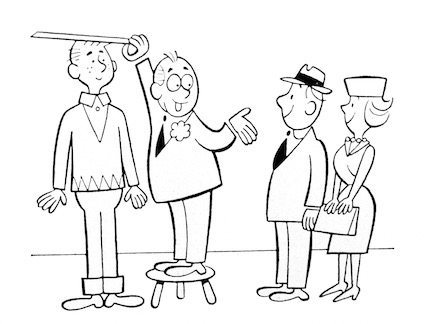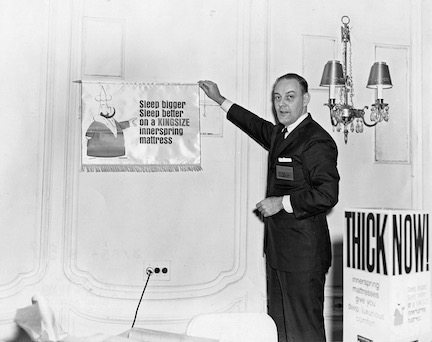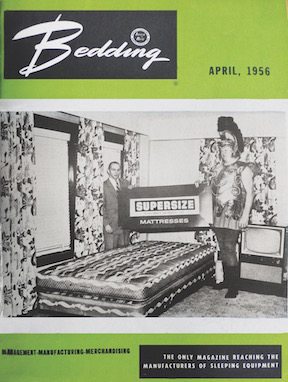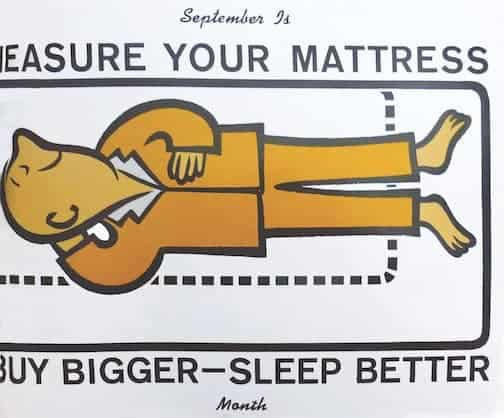Part III of the second installment on the International Sleep Products Association’s first 100 years

An illustration in Bedding magazine highlighted the fact that Americans were growing taller in the 1950s than they had in 1900.
Supersize it! We’re talking about mattress sizes
BY JULIE A. PALM
Decades before fast-food chains got the idea to supersize their fries and sodas, the bedding industry set out to upsize mattresses.
Even into the 1940s, Americans slept primarily on twin or double beds. Occasionally, the mattress industry promoted the idea of purchasing two new twins—a not-so-subtle way of getting consumers to buy twice as much bedding. Frankly, the idea never got much traction.
Midway through the decade, manufacturers began to introduce larger mattresses (later called and standardized as “queen” and “king”), but the bigger beds didn’t make much of an impact on the market until the 1950s.
“We attempt to show the customer that he needs a bigger mattress and spring,” said William London, owner of Cleveland-based London Furniture & Carpet Co. in a November 1954 article in Bedding Merchandiser magazine. “We point out to the reluctant ones that for a few additional dollars more than he had budgeted, he can assure himself comfortable sleeping.”

An unidentified manufacturer helped spread the bigger bed message.
The retailer did a good business in supersize mattresses priced from $69 to $79. “The customer is advised it will cost him only one dollar more each additional inch of length,” London said. Same deal for a wider bed: $1 more for an extra inch across.
A number of forces were merging to create demand for roomier mattresses, among them the fact that Americans were getting larger themselves. An October 1963 article in Bedding magazine reported that in 1900, only 4% of adult men in the United States were 6 feet or taller. By 1959, the number was 20% and women were growing taller at similar rates.
Then there were the post-war economic booms: Consumers were eager to outfit those big houses in the sprawling suburbs with new furniture.

Bedding magazine featured this herculean promotion on the April 1956 cover.
Finally, bedding manufacturers had allies in wanting to significantly boost sales of mattresses, particularly the supersizes. After a hiatus of several years, the National Association of Bedding Manufacturers brought back Better Sleep Month in 1961 and enlisted the help of several groups—the United States Steel Corp., the Latex Foam Rubber Council of the Rubber Manufacturers Association and the Cotton Batting Institute—to support and promote it. Those groups represented many companies that ramped up production capacity during the wars and wanted to keep those factories busy while meeting the needs of the burgeoning middle class.
“What this country needs is larger beds and smaller cars—and we already have the latter. But in bedding, width is now even more important than length. Too many people are still sleeping two in a ‘full-size’ bed that provides only 27 inches—or crib space—for each person,” J. Paul Fanning, NABM secretary and general manager said during a meeting held in May 1961 to discuss further revisions to bedding-size standards to include both “conventional” and “oversize” mattresses, foundations and frames. That line comparing full-size beds to cribs was a winner, repeated regularly by the industry in PR efforts.

The mattress industry encouraged consumers to upgrade to larger bedding in September 1962 with “Measure Your Mattress Month.”
The next year, the industry went even bigger—pardon the pun—to encourage consumers to upgrade to new, larger-size bedding. NABM deemed Better Sleep Month “Measure Your Mattress Month” with a “Buy Bigger, Sleep Better!” tagline and planned one of the largest industry PR efforts ever. Again, the outside groups offered both financial and tactical support and were joined by others, including Jones & Laughlin Steel Corp., Bethlehem Steel and the National Retail Furniture Association. There was an enormous multimedia push with press kits sent to more than 2,500 newspapers and magazines and scripts prepped for TV and radio stations nationwide. Manufacturers and retailers were encouraged to create their own promotional events, tied to the industry’s larger message.
The campaign was an enormous success: In 1953, king-size bedding represented less than 1% of overall bedding sales in the United States, according to an article in the October 1963 issue of Bedding. In 1961, it had risen to 5.5% and just a year later, it accounted for 10% of sales. Big gains, indeed.




